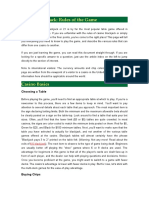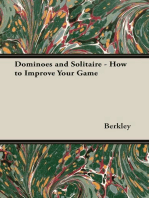25 Randomthings
25 Randomthings
Uploaded by
rzbackup1426Copyright:
Available Formats
25 Randomthings
25 Randomthings
Uploaded by
rzbackup1426Original Title
Copyright
Available Formats
Share this document
Did you find this document useful?
Is this content inappropriate?
Copyright:
Available Formats
25 Randomthings
25 Randomthings
Uploaded by
rzbackup1426Copyright:
Available Formats
For 2-6 players
AGES Teen to Adult
OBJECT OF THE GAME
You compete to be the first player to complete a personal list of “25 Random Things About Me.” The cards will
provide some items for your list. But, if you know the other players well, you’ll be able to add more and more
personal things of your own choice.
CONTENTS
200 game cards, Pad of list making paper, 12 Cardboard tokens (6 large and 6 small)
SETUP
Each player selects one large token. Keep yours in front of you. It represents you during the game. Place the small
token of each player’s type in the center of the table. Keep out of play any remaining tokens. Each player receives
a sheet of list paper and a pen or pencil. Place one deck of cards in the center of the table, either side up.
Next, take the top 7 cards from the deck and spread them in the center of the table, either side up.
HOW TO PLAY
The oldest player goes first. This player becomes the game’s first “reader.” Play will pass to the left.
When it is your turn, place all the small tokens in front of you. Arrange the 7 cards so you can read the random
facts on them. Decide on one of these to play. Read aloud the fact on this card. Try to think about which of your
opponents that fact applies to. Secretly, select and keep in a closed hand the small token that represents each
player you feel will say, “Yes—that random fact applies to me!” Should the fact also fit you, place your own small
token in your hand as well. Hide the tokens not selected. Each other player must place his large token face-up for
“Yes,” or face-down for “No.” This should also be done in secret (players are advised to hide their token under
their list). The reader then reveals the tokens held in hand. One by one, each opponent reveals his large token.
Everyone will quickly see which “yes” matches the reader’s guess.
• Each player whom the reader correctly matched “scores.” This means he can write this random fact on his “25
Random Things About Me” list. (The reader also writes this random fact if he included his own token in hand.)
• The reader scores one “bonus fact” for each “yes” match made. The bonus fact can be any personal random
thing about himself. He writes this on the next line of his list. These will make each list personal (and fun to read at
the end of the game). The lists can make each game different, depending on what facts you recall about yourself.
• No fact can be added to lists without a match being made.
• For example, the card says, “I like cold pizza”—the reader correctly matches two players who DO like cold
pizza—both of these players may now write “I like cold pizza” on their lists as does the reader. The reader
scores two bonus facts as well. He writes on his list two other random facts about himself.
• But if “I like cold pizza” did not connect with any other player, the reader would score no bonus fact. He
could write this fact on his list only if he voted for himself (because he likes cold pizza).
After each player’s turn, discard the card read by the reader. The next reader replaces this card with a fresh one
from the top of the deck.
END OF GAME/WINNING
As soon as one player completes his list of 25 random facts, game play stops and this player wins. Players may now
read aloud their lists and enjoy discussion about them.
RANDOM THINGS ABOUT 25 RANDOM THINGS ABOUT ME
• When you are the reader, you can select a random fact off either side of the card. It’s okay to flip the cards over
and check out both sides before you select the card you want to read.
• If you select a card that has a “fill-in-the-blank” space, it is best if you complete the statement in a way that will
match as many players as possible.
• 25 Random Things About Me is a fun social activity. Don’t think of it as a serious, competitive game. The conversations
it inspires are fun. And you really will get to know your friends and family.
For more information about Winning Moves product safety and compliance please
visit: http://www.winning-moves.com/product_safety.
Contact Us: Phone: 1-800-664-7788 ext. 114
Winning Moves Games Fax: 978-739-4847
75 Sylvan Street, Suite C-104 Email: wmoves@winning-moves.com
Danvers, MA 01923
25 Random Things About Me is a trademark of Winning Moves Inc. All Rights Reserved.
© 2009 Winning Moves Inc., Danvers, MA 01923 Colors and parts may vary. Made in the USA.
11417107BU
You might also like
- Cartoon Network Crossover Crisis Game RulesNo ratings yetCartoon Network Crossover Crisis Game Rules9 pages
- Exam Questions by Topic (Higher) (Bicen Maths)No ratings yetExam Questions by Topic (Higher) (Bicen Maths)1,139 pages
- 06e 1MA1 3H November 2023 Mark Scheme (Word)No ratings yet06e 1MA1 3H November 2023 Mark Scheme (Word)26 pages
- 7641 01 3d Tetris Cube Powerpoint Diagram 6 Pieces 16x9No ratings yet7641 01 3d Tetris Cube Powerpoint Diagram 6 Pieces 16x98 pages
- Aquatic Activities For School Swimming CarnivalsNo ratings yetAquatic Activities For School Swimming Carnivals2 pages
- Blackjack: How To Play Blackjack: A Beginner to Expert Guide: to Get You From The Sidelines to Running the Blackjack Table, Reduce Your Risk, and Have FunFrom EverandBlackjack: How To Play Blackjack: A Beginner to Expert Guide: to Get You From The Sidelines to Running the Blackjack Table, Reduce Your Risk, and Have FunNo ratings yet
- How to Play Card Games: A Beginners Card Game Rule Book of Over 100 Popular Playing Card Variations for Families Kids and Adults: Card Games for Families, #1From EverandHow to Play Card Games: A Beginners Card Game Rule Book of Over 100 Popular Playing Card Variations for Families Kids and Adults: Card Games for Families, #1No ratings yet
- Card Games Properly Explained: Poker, Canasta, Cribbage, Gin Rummy, Whist, and Much MoreFrom EverandCard Games Properly Explained: Poker, Canasta, Cribbage, Gin Rummy, Whist, and Much More1.5/5 (2)
- Casino Blackjack: Rules of The Game: Choosing A TableNo ratings yetCasino Blackjack: Rules of The Game: Choosing A Table13 pages
- LIBRE BASKERVILLE GAME JAM 2019 - Casino LocaleNo ratings yetLIBRE BASKERVILLE GAME JAM 2019 - Casino Locale2 pages
- Best 2-Player Card Games: Top 10 Fun Card Games For 2 People 2021No ratings yetBest 2-Player Card Games: Top 10 Fun Card Games For 2 People 202124 pages
- What Are The Odds - The Mathematics of Gambling PDF100% (1)What Are The Odds - The Mathematics of Gambling PDF6 pages
- 02-zombies-x-feeding-the-addiction-rulebookNo ratings yet02-zombies-x-feeding-the-addiction-rulebook2 pages
- Level 5 Probability and Randomness Gone Horribly Wrong - Game Balance ConceptsNo ratings yetLevel 5 Probability and Randomness Gone Horribly Wrong - Game Balance Concepts19 pages
- It's in the Book: Winning Ways - How to Beat the CasinosFrom EverandIt's in the Book: Winning Ways - How to Beat the CasinosNo ratings yet
- Better Fiasco Rules Mccravianized Copy 2 0 2 2No ratings yetBetter Fiasco Rules Mccravianized Copy 2 0 2 24 pages
- IJTMGH - Volume 10 - Issue 1 - Pages 1-3No ratings yetIJTMGH - Volume 10 - Issue 1 - Pages 1-33 pages
- Long Division of Polynomials Exam QuestionsNo ratings yetLong Division of Polynomials Exam Questions6 pages
- TỔNG HỢP VIẾT LẠI CÂU DESTINATION B2,C1,C2,FCE,CAENo ratings yetTỔNG HỢP VIẾT LẠI CÂU DESTINATION B2,C1,C2,FCE,CAE23 pages
- Avatar The Last Airbender D20 RPG Printable100% (1)Avatar The Last Airbender D20 RPG Printable83 pages
- Wmvol 01-24 The Clever Son and The Confused LoversNo ratings yetWmvol 01-24 The Clever Son and The Confused Lovers4 pages
- 2014 Official North Carolina Travel GuideNo ratings yet2014 Official North Carolina Travel Guide175 pages
- ForgedAnvil's D&D 5E Character Generator v2.00 Instructions For UseNo ratings yetForgedAnvil's D&D 5E Character Generator v2.00 Instructions For Use24 pages
- The Technology Behind The Elemental Demo (Unreal Engine 4)100% (1)The Technology Behind The Elemental Demo (Unreal Engine 4)71 pages







































































































